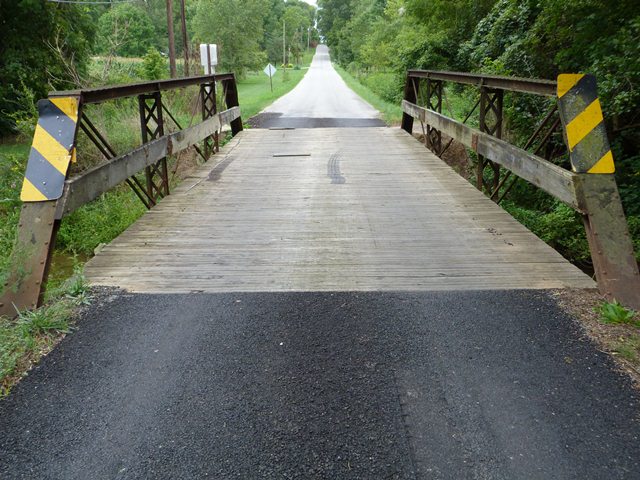We Recommend:
Bach Steel - Experts at historic truss bridge restoration.
BridgeHunter.com Phase 1 is released to the public! - Visit Now
Phillips Road Bridge

Primary Photographer(s): Nathan Holth
Bridge Documented: August 11, 2012
Rural: Morrow County, Ohio: United States
By Builder/Contractor: Unknown
1990
41.0 Feet (12.5 Meters)
42.0 Feet (12.8 Meters)
11.8 Feet (3.6 Meters)
1 Main Span(s)
5931622

View Information About HSR Ratings
Bridge Documentation
This bridge is in storage!
Bridge Status: Replaced, but put in storage and marketed for reuse.View Archived National Bridge Inventory Report - Has Additional Details and Evaluation
This is a small example of a pin-connected pony truss. The end panels of the truss have a bottom chord that is a pair of lightweight eye rods (as opposed to the more common eye bars). Normally, lightweight rod is sometimes found in the end panels of only the smallest pony truss bridges, like this example. The bridge has wooden railings and is seated on stone abutments. The bridge appears to have no noteworthy alterations from its original design. The hangers appear to have been replaced in kind.
Information and Findings From Ohio's Historic Bridge InventorySetting/Context The bridge carries a 1 lane rural road over a stream in a rural area of active farms and modern houses. Posted 6 tons since 1969. Physical Description The 1 span, 42'-long, pin-connected Pratt pony truss bridge is supported on ashlar abutments. The truss lines are traditionally composed with box section for the upper chords and inclined end posts and eye bars for the diagonals and lower chords. The verticals are toe-out channels with lacing. Steel is marked "Carnegie." Integrity Impacted rust on box section members; lost rivets. Summary of Significance The date of construction of the ca. 1892 pin connected Pratt pony truss bridge is not documented in Morrow County records, but stylistically it represents the standardization of design typical of ca. 1890 and
later bridges. It is one of 20 examples of the important bridge type in Morrow County with the oldest extant example dating to 1874. Many are undocumented and represent the era of standardization. Morrow County retains many
deteriorating pin connected truss bridges largely because of the economic issues associated with there replacement in a largely rural county with no industrial tax base. This example is not historically or technologically
significant. Bridge Considered Historic By Survey: No |
![]()
Photo Galleries and Videos: Phillips Road Bridge
Bridge Photo-Documentation
Original / Full Size PhotosA collection of overview and detail photos. This gallery offers photos in the highest available resolution and file size in a touch-friendly popup viewer.
Alternatively, Browse Without Using Viewer
![]()
Bridge Photo-Documentation
Mobile Optimized PhotosA collection of overview and detail photos. This gallery features data-friendly, fast-loading photos in a touch-friendly popup viewer.
Alternatively, Browse Without Using Viewer
![]()
Eastbound Crossing
Full Motion VideoStreaming video of the bridge. Also includes a higher quality downloadable video for greater clarity or offline viewing.
![]()
Westbound Crossing
Full Motion VideoStreaming video of the bridge. Also includes a higher quality downloadable video for greater clarity or offline viewing.
![]()
Maps and Links: Phillips Road Bridge
Coordinates (Latitude, Longitude):
Search For Additional Bridge Listings:
Bridgehunter.com: View listed bridges within 0.5 miles (0.8 kilometers) of this bridge.
Bridgehunter.com: View listed bridges within 10 miles (16 kilometers) of this bridge.
Additional Maps:
Google Streetview (If Available)
GeoHack (Additional Links and Coordinates)
Apple Maps (Via DuckDuckGo Search)
Apple Maps (Apple devices only)
Android: Open Location In Your Map or GPS App
Flickr Gallery (Find Nearby Photos)
Wikimedia Commons (Find Nearby Photos)
Directions Via Sygic For Android
Directions Via Sygic For iOS and Android Dolphin Browser
USGS National Map (United States Only)
Historical USGS Topo Maps (United States Only)
Historic Aerials (United States Only)
CalTopo Maps (United States Only)


